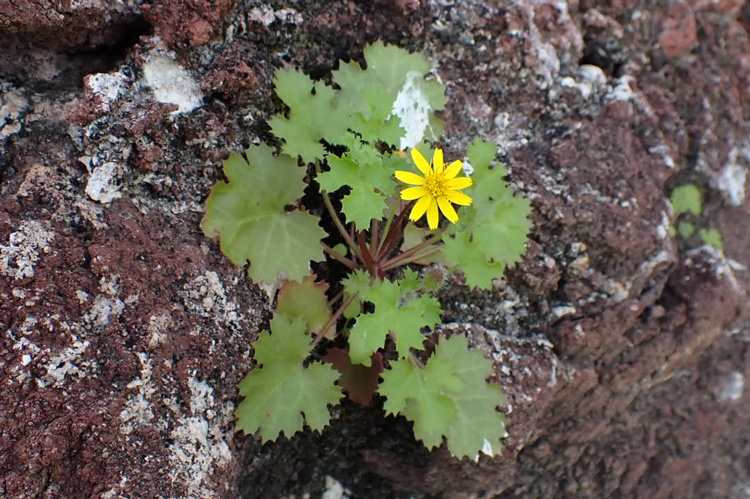
Rock daisies are plants of arid micro-habitats, such as exposed rock outcrops. Their adaptations to the stresses of life on bare cliffs made them ideally suited to invading desert areas of the American Southwest as they expanded over the past 5 to 7 million years. (Photo credit: Isaac Lichter-Marck)
At a time when climate change is making many areas of the planet hotter and drier, it's sobering to think that deserts are relatively new biomes that have grown considerably over the past 30 million years. Widespread arid regions, like the deserts that today cover much of western North America, began to emerge only within the past 5 to 7 million years.
Understanding how plants that invaded these harsh deserts biomes were able to survive could help predict how ecosystems will fare in a drier future.
An intensive study of a group of plants that first invaded emerging deserts millions of years ago concludes that these pioneers - rock daisies - did not come unequipped to deal with heat, scorching sun and lack of water. They had developed adaptations to such stresses while living on dry, exposed rock outcroppings within older, more moist areas and even tropical forests, all of which made it easier for them to invade expanding arid areas.
The study by University of California, Berkeley, researcher Isaac Lichter-Marck is the first to provide evidence to resolve a long-standing evolutionary debate: Did iconic desert plants, like the stately saguaro cacti, the flaming ocotillos and the Seussian agaves, adapt to arid conditions only after they invaded deserts? Or did they come preadapted to the stresses of desert living?
The question has relevance today, Lichter-Marck said, because accelerating aridity due to climate change is challenging plants to adapt much more quickly than they have in the past. Already, about one-fifth of Earth's land surface is desert. If adaptation to arid conditions was only possible for plants that had already evolved to deal with such stresses, then many today may not be equipped with an adequate genetic tool kit to survive.

A carpet of ephemeral wildflowers paints the desert yellow in Anza Borrego State Park. These blooms are dominated by a few species of plants in the daisy family (Compositae). Many daisies possess an annual life cycle that allows them to germinate, flower and go to seed within the short window of favorable conditions that follow rain, effectively escaping the harsh, dry conditions that typically characterize desert life. Rio, a blue heeler or Australian cattle dog, was an important part of the field team that helped locate rock daisies across wide swaths of rugged desert terrain. (Photo credit: Isaac Lichter-Marck)
"If you think about aridity only as a stimulus to plant evolution, then in many cases people could say these plants are survivors, they are adaptable, and they will be fine. They will take advantage of these new conditions, and they will thrive," said Lichter-Marck, who is also a National Science Foundation postdoctoral research fellow at UCLA.
But the history of rock daisies suggests that "when the deserts emerged, those plants that had the necessary preadaptations to take advantage of new conditions were the ones that thrived," he said. "Adding more aridification to the system doesn't necessarily mean more rapid adaptive evolution will occur. There's a limited source of lineages that can take advantage of new levels of aridity, and that is important for understanding the effect of climate change on biodiversity."
Lichter-Marck and Bruce Baldwin, UC Berkeley professor of integrative biology, curator of the Jepson Herbarium and chief editor of The Jepson Desert Manual: Vascular Plants of Southeastern California (2002), published their study about the evolution of rock daisies in North American deserts this week in the journal Proceedings of the National Academy of Sciences.
Seven years roaming the desert
Botanists realized long ago that when plants invaded desert areas, they quickly diversified to fill the many niches created by this new type of habitat.

The alcove or hanging-garden rock daisy (Laphamia specuicola), seen here on steep sandstone cliffs in Arches National Park in Moab, Utah, was only recently identified and described as a new species. Hanging gardens, found throughout the Colorado plateau, form in vertical or overhanging walls of eroded sandstone and provide a lush niche for a diverse and specialized flora of cliff dwelling plants. (Photo credit: Isaac Lichter-Marck)
"Even as recently as 1 million to 1.5 million years ago, it would have been difficult to find widespread desert habitats like we see today in North America, which is kind of surprising because now deserts and arid habitats are the most widespread biome on earth," Lichter-Marck said. "But during the late Miocene Epoch, dry habitats spread, and the world's lineages of desert plants, especially the succulent lineages like the cacti, the agaves and the ice plants - as well as many other drought tolerant lineages - underwent a synchronous rapid diversification."
Paleontologists pointed out, however, that fossilized plants that thrived tens of millions of years before the proliferation of deserts had characteristics similar to those of desert plants today. Some scientists, like the late paleoecologist Daniel Axelrod of UCLA and UC Davis, argued that this meant the plants that thrived in the desert today evolved earlier and were preadapted - or exapted - to survive desert conditions by growing in dry microsites, such as rock outcrops, rain shadows or mountaintops. Others, like UC Berkeley's Ledyard Stebbins, an evolutionary biologist who helped found the UC Davis Department of Genetics, argued that aridity itself spurred plants to diversify and develop traits to withstand dryness, heat, intense sunlight and strong winds.
Despite the similarities between rocky outcrops and deserts, it has been hard to prove that desert plants descended from plants already adapted to the stresses of aridity, in part because fossils rarely form in dry habitats and cannot tell us much about the habitat in which these ancient plants were growing.

The Baja California rock daisy (Laphamia lobata) grows on bare outcrops and cliffs of volcanic rock. Lichter-Marck and Baldwin carried out a comprehensive clade-based study of the rock daisies and found compelling evidence that drought tolerance traits typically attributed to adaptation to an arid climate evolved prior to establishment in deserts. The results underscore the importance of preadaptation on open, rocky substrates as a precursor to the evolution of drought tolerance in desert flora and raise concerns that aridification caused by climate change may outpace plant adaptive evolution. (Photo credit: Isaac Lichter-Marck)
To Lichter-Marck and Baldwin, rock daisies, which are classified in the tribe Perityleae in the sunflower family, seemed like a good group in which to explore the connection. Some species live on dry, exposed rock in tropical areas of Mexico - what might be considered "micro-deserts" - while others have fully adapted to desert areas, such as the Mojave in California and the Great Basin, Chihuahuan and Sonoran deserts that cover most of western North America.
"Plants that live on rock outcrops face many of the same challenges as those living in a dry, desert habitat," Lichter-Marck said. "Rock outcrops tend to be exposed to UV light, wind and dry, desiccating conditions, as well as heat and frost. They also tend to be more exposed to herbivores.
"The ways that plants deal with them are diverse, but they usually involve some kind of specialized root morphology that helps them to anchor in rock outcrops, as well as deal with the heightened arid conditions. And they tend to have smaller leaves, or leaves with a dense covering of hairs that help buffer them against drought and block sunlight, including UV light. They also tend to have heightened chemical defenses against herbivores, because it takes a lot of energy to regenerate after being munched."
For his Ph.D. thesis in the Department of Integrative Biology and at the Jepson Herbarium, Lichter-Marck, a Southern California native, roamed the deserts of Arizona, California, Texas and Mexico for months at a time in a pickup truck, accompanied by his blue heeler, Rio, to collect hundreds of specimens of rock daises. Some rock daisies are among the most dramatic bloomers in spring, carpeting the desert with colorful blossoms. Many, however, are limited to small geographic regions where they grow only on vertical rock faces or sky island mountain ranges, making them hazardous to collect. Lichter-Marck is an experienced mountaineer, an important skillset for field work in rough terrain.

Brandegee's rock daisy (Perityle brandegeeana) is one of the most abundant annual wildflowers of low Sonoran desert habitats in the Vizcaino region of Baja California, where it may carpet miles of badlands for months at a time. The name honors Katherine Brandegee, a pioneering botanist and curator of the California Academy of Sciences herbarium. (Photo credit: Isaac Lichter-Marck)
He later sequenced the DNA of these specimens - 73 of the 84 recognized species of rock daisy - and catalogued their life histories, such as where they grew, what type of root system they had, and whether they were annual or perennial, an herb or a shrub. He then compared them to fossilized daisies to develop a rough timeline of the evolution of these characteristics and the lineage's eventual shift into deserts.
This allowed him to conclude that most rock daises - in particular, the genus Laphamia, which was the first to move into deserts and is the largest rock daisy genus - had adapted to the stress of heat, aridity, wind and sun by virtue of their growth on cliffs before invading deserts.
"This is a clear empirical demonstration of what was originally Axelrod's hypothesis - of a desert plant group originating in dry microclimates prior to the widespread emergence of desert habitats," said Lichter-Marck. "What this means is that the strategies for drought tolerance that are so characteristic of desert vegetation might not actually represent responses to the dry conditions found in deserts. Instead, they could be traits that evolved earlier in association with much older and more stable dry microclimates, such as rock outcrops in tropical settings."
Preadaptation may be the key to the success of many desert plants, including cacti, which are known to inhabit rock outcrops or grow as epiphytes in the canopies of trees within tropical areas, though these large lineages would require a much more extended analysis, he said.
Rock daisies, many of which live in specialized habitats that make them vulnerable to extinction, highlight the importance of conserving seemingly niche species.
"A lot of the rock daisies are very specialized and tend to be very narrow in their distribution and might be seen as less significant to the survival of the ecosystem as a whole. In evolutionary biology and in conservation biology, specialized organisms with narrow geographic ranges are often considered vulnerable lineages and have sometimes even been called evolutionary dead ends," he said. "An important implication here is that a group of ecological specialists growing on scattered cliffs in tropical habitats started this major radiation in the desert. So, it actually shows that specialists are not just these vulnerable lineages on the edge of extinction. They might actually be really important sources for innovation in evolution."
Lichter-Marck is currently extending his study of plants that grow on rock outcrops to Hawai'i, where many rare endemic species live only on the sides of steep mountains. Instead of scaling precarious cliffsides to reach rare specimens, however, he hopes to use drones.
The work was funded by the Smithsonian Institution Fellowship Program, Philomathia Foundation, UC Berkeley Department of Integrative Biology, University of California Natural Reserve System, Society of Systematic Biologists, American Society of Plant Taxonomists, California Native Plant Society, California Botanical Society, Southern California Botanists and the Lawrence R. Heckard Fund of the Jepson Herbarium.







